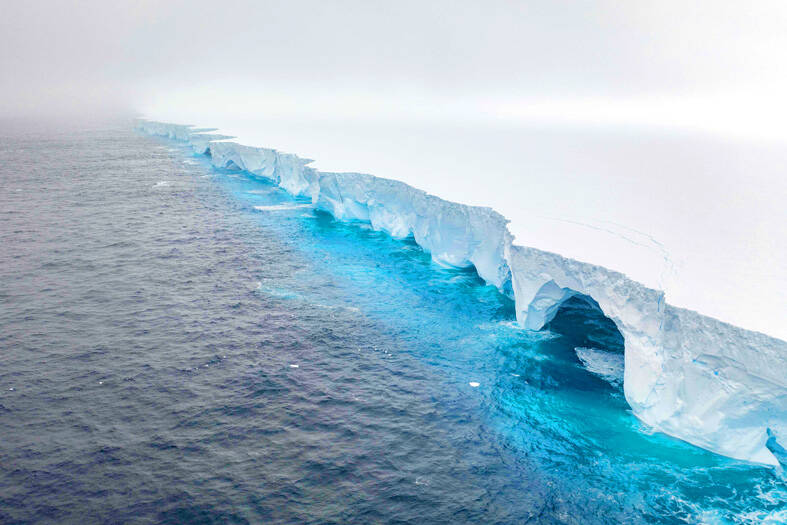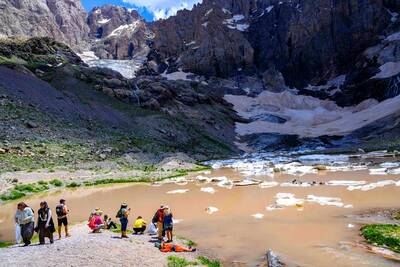The world’s biggest iceberg appears to have run aground about 70km from a remote antarctic island, potentially sparing the crucial wildlife haven from being hit, a research organization said on Tuesday.
The colossal iceberg A23a — which is more than twice the size of London and weighs about 1 trillion tonnes — has been drifting north from Antarctica toward South Georgia island since 2020.
This had raised fears it could collide with the island or run aground in shallower water near it, potentially disrupting the ability of penguins and seals to feed their young.

Photo: EYOS Expeditions via AFP
However, the gigantic wall of ice has been stuck 73km from the island since Saturday last week, the British Antarctic Survey said in a statement.
“If the iceberg stays grounded, we don’t expect it to significantly affect the local wildlife,” British Antarctic Survey oceanographer Andrew Meijers said.
“In the last few decades, the many icebergs that end up taking this route through the Southern Ocean soon break up, disperse and melt,” added Meijers, who encountered A23a in late 2023 and has tracked its fate via satellite ever since.
Satellite images analyzed by AFP showed that the closest edge of the roughly 3,300km2 iceberg had stopped more than 70km from the island late last month.
It remains unclear whether the iceberg is stuck for good.
“It will be interesting to see what will happen now,” Meijers added.
The world’s biggest and oldest iceberg calved from the antarctic shelf in 1986.
It remained stuck for more than 30 years before finally breaking free in 2020, its lumbering journey north sometimes delayed by ocean forces that kept it spinning in place.
Satellite imagery had previously suggested it was not crumbling into smaller chunks along the familiar path that such icebergs take.
However, a 19km chunk broke off in January.
There had been concerns for wildlife on the crucial breeding ground of South Georgia if the iceberg parked too close. This would have forced animals such as penguins and seals to travel much farther to get around the colossal block of ice.
“This could reduce the amount of food coming back to pups and chicks on the island, and so increase mortality,” Meijers said.
However, in its current location, the iceberg could offer benefits to wildlife.
“Nutrients stirred up by the grounding [of the iceberg] and from its melt may boost food availability for the whole regional ecosystem, including for charismatic penguins and seals,” Meijers said.
Along with the nearby South Sandwich islands, South Georgia is home to about 5 million seals and 65 million breeding birds from 30 different species.
The island’s seals and penguins have already had a “bad season” due to a bird flu outbreak, Meijers said in January.
The iceberg poses no threat to shipping. It is so huge that vessels can easily avoid it.
However, as it breaks up into smaller pieces, certain areas could become off limits to commercial fishing ships “due to the number of smaller — yet often more dangerous — bergy bits,” Meijers said.
There is no permanent human population on South Georgia, which the UK administers as a British overseas territory.
Argentina also claims the island — along with the Falklands to the west which it calls Las Malvinas. Icebergs of this size are rare, but not unheard of. There have been two of similar size in the same area over the past five years, Meijers said.
Such huge icebergs are a “completely normal part of the lifecycle” of the antarctic ice sheets, Meijers said.
However, ice shelves have lost 6,000 billion tonnes of mass since 2000, which is matched by accelerating ice loss attributed to climate change, he added.
Researchers warned last month that a rise in the planet’s average temperature to between 1.5°C and 2.0°C above preindustrial levels could melt enough frozen water to lift oceans by a dozen meters — and beyond the point of no return.
Last year — which smashed previous heat records as the world was battered by fires, floods and storms — was the first calendar year above 1.5°C.

In the sweltering streets of Jakarta, buskers carry towering, hollow puppets and pass around a bucket for donations. Now, they fear becoming outlaws. City authorities said they would crack down on use of the sacred ondel-ondel puppets, which can stand as tall as a truck, and they are drafting legislation to remove what they view as a street nuisance. Performances featuring the puppets — originally used by Jakarta’s Betawi people to ward off evil spirits — would be allowed only at set events. The ban could leave many ondel-ondel buskers in Jakarta jobless. “I am confused and anxious. I fear getting raided or even

Kemal Ozdemir looked up at the bare peaks of Mount Cilo in Turkey’s Kurdish majority southeast. “There were glaciers 10 years ago,” he recalled under a cloudless sky. A mountain guide for 15 years, Ozdemir then turned toward the torrent carrying dozens of blocks of ice below a slope covered with grass and rocks — a sign of glacier loss being exacerbated by global warming. “You can see that there are quite a few pieces of glacier in the water right now ... the reason why the waterfalls flow lushly actually shows us how fast the ice is melting,” he said.

RISING RACISM: A Japanese group called on China to assure safety in the country, while the Chinese embassy in Tokyo urged action against a ‘surge in xenophobia’ A Japanese woman living in China was attacked and injured by a man in a subway station in Suzhou, China, Japanese media said, hours after two Chinese men were seriously injured in violence in Tokyo. The attacks on Thursday raised concern about xenophobic sentiment in China and Japan that have been blamed for assaults in both countries. It was the third attack involving Japanese living in China since last year. In the two previous cases in China, Chinese authorities have insisted they were isolated incidents. Japanese broadcaster NHK did not identify the woman injured in Suzhou by name, but, citing the Japanese

RESTRUCTURE: Myanmar’s military has ended emergency rule and announced plans for elections in December, but critics said the move aims to entrench junta control Myanmar’s military government announced on Thursday that it was ending the state of emergency declared after it seized power in 2021 and would restructure administrative bodies to prepare for the new election at the end of the year. However, the polls planned for an unspecified date in December face serious obstacles, including a civil war raging over most of the country and pledges by opponents of the military rule to derail the election because they believe it can be neither free nor fair. Under the restructuring, Myanmar’s junta chief Min Aung Hlaing is giving up two posts, but would stay at the